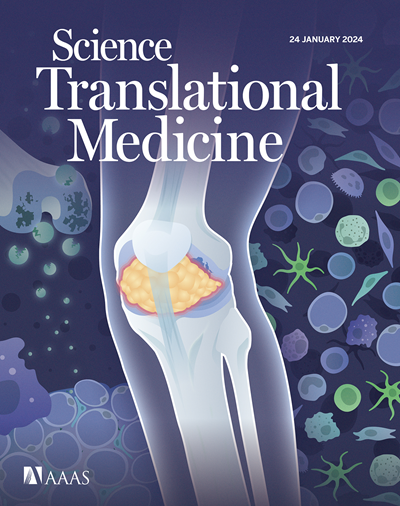神经元HDAC3敲低促进脊髓损伤小鼠模型本体脊髓绕道通路形成和运动恢复
IF 14.6
1区 医学
Q1 CELL BIOLOGY
引用次数: 0
摘要
本体脊髓绕道通路促进脊髓损伤(SCI)后运动恢复。在这里,通过筛选表观遗传调节剂,我们证明了小干扰RNA (siRNA)介导的组蛋白去乙酰化酶3的敲低,通过细胞外囊泡(EVsiHDAC3)传递,促进了小鼠脊髓神经元和人类诱导的多能干细胞来源的感觉和运动神经元的神经突生长。为了提高体内疗效,我们利用明胶甲基丙烯酰微球偶联了一种优化的狂犬病糖蛋白衍生肽,开发了一种神经营养纳米颗粒平台。脊髓递送装载evsihdac3的平台(oGHDAC3)或腺相关病毒介导的神经元HDAC3缺失促进了小鼠交错双半切脊髓损伤后本体-腰椎绕行回路的形成并改善了运动。在oGHDAC3治疗后,受损的本体脊髓接力神经元的化学发生沉默得以恢复。我们观察到oGHDAC3在小鼠全脊髓横断后没有治疗作用,进一步表明保留的椎管内回路是运动恢复的神经基质。在机制上,病变间神经元中Stat3的缺失,加上mTOR的失活,消除了oGHDAC3的有益作用。最后,将oGHDAC3与KCC2激动剂CLP290联合使用,进一步改善绕行电路功能,从而实现一致的体重支撑步进。我们的研究结果表明,将sirna介导的HDAC3抑制与嗜神经生物异常材料平台结合可能是一种可翻译的方法,用于恢复不完全性脊髓损伤后的运动功能。本文章由计算机程序翻译,如有差异,请以英文原文为准。
Neuronal HDAC3 knockdown promotes propriospinal detour pathway formation and locomotor recovery in a mouse model of spinal cord injury
Propriospinal detour pathways facilitate motor recovery after spinal cord injury (SCI). Here, through a screen of epigenetic modulators, we demonstrated that small interfering RNA (siRNA)–mediated knockdown of histone deacetylase 3, delivered by extracellular vesicles (EVsiHDAC3), promoted neurite outgrowth in murine spinal neurons and human induced pluripotent stem cell–derived sensory and motor neurons. To enhance in vivo efficacy, we developed a neurotrophic nanoparticle platform using gelatin methacryloyl microspheres conjugated with an optimized rabies glycoprotein–derived peptide. Spinal delivery of the EVsiHDAC3-loaded platform (oGHDAC3) or adeno-associated virus–mediated neuronal HDAC3 deletion facilitated propriospino-lumbar detour circuit formation and improved locomotion after staggered double hemisection SCI in mice. Chemogenetic silencing of propriospinal relay neurons compromised recovered stepping upon oGHDAC3 treatment. We observed no therapeutic effects of oGHDAC3 after full spinal transection in mice, further suggesting that spared intraspinal circuits serve as the neural substrates for locomotion recovery. Mechanistically, Stat3 deletion in interlesional neurons, combined with mTOR inactivation, abolished the beneficial effects of oGHDAC3. Finally, combining oGHDAC3 with CLP290, a KCC2 agonist, further improved detour circuit functionality, resulting in consistent weight-supported stepping. Our findings suggest that integrating siRNA-mediated HDAC3 inhibition with a neurotropic bionanomaterial platform could be a translatable approach for restoring motor function after incomplete SCI.
求助全文
通过发布文献求助,成功后即可免费获取论文全文。
去求助
来源期刊

Science Translational Medicine
CELL BIOLOGY-MEDICINE, RESEARCH & EXPERIMENTAL
CiteScore
26.70
自引率
1.20%
发文量
309
审稿时长
1.7 months
期刊介绍:
Science Translational Medicine is an online journal that focuses on publishing research at the intersection of science, engineering, and medicine. The goal of the journal is to promote human health by providing a platform for researchers from various disciplines to communicate their latest advancements in biomedical, translational, and clinical research.
The journal aims to address the slow translation of scientific knowledge into effective treatments and health measures. It publishes articles that fill the knowledge gaps between preclinical research and medical applications, with a focus on accelerating the translation of knowledge into new ways of preventing, diagnosing, and treating human diseases.
The scope of Science Translational Medicine includes various areas such as cardiovascular disease, immunology/vaccines, metabolism/diabetes/obesity, neuroscience/neurology/psychiatry, cancer, infectious diseases, policy, behavior, bioengineering, chemical genomics/drug discovery, imaging, applied physical sciences, medical nanotechnology, drug delivery, biomarkers, gene therapy/regenerative medicine, toxicology and pharmacokinetics, data mining, cell culture, animal and human studies, medical informatics, and other interdisciplinary approaches to medicine.
The target audience of the journal includes researchers and management in academia, government, and the biotechnology and pharmaceutical industries. It is also relevant to physician scientists, regulators, policy makers, investors, business developers, and funding agencies.
 求助内容:
求助内容: 应助结果提醒方式:
应助结果提醒方式:


